Most of us have a few tools around the house. At minimum, we’ve got a few screwdrivers, wrenches, and other basic hand tools. But in a world that’s going increasingly electronic, having a multimeter is almost incredibly essential.
Basic multimeters are capable of measuring voltage, resistance, and current. Both voltage and resistance can be measured by simply touching the probes across the circuit. Want to know if your battery still has any juice? Put the probes on each of the terminals. Want to see if the motor in your dryer still works? Measure resistance across the motor. All of these measurements are, provided you take reasonable precautions, safe. It’s very unlikely that a multimeter could ever cause you harm. But current is the exception.
Current requires that you physically break a circuit, and put the meter in line with it. If you were trying to measure the current going through an appliance, you’d have to remove the positive terminal from the motor, connect it to the positive terminal on the meter, and connect the negative terminal on the meter to the positive terminal on the motor. This can be extremely dangerous because you are potentially making yourself part of the circuit. With AC electricity in particular, this can easily stop your heart.
This is why every electrician has a clamp meter. All current emits magnetic radiation. Clamp meters simply put a sensor around the cable and determine the current based on the magnetic radiation. Taking a quick current measurement can be done without powering down the device in a matter of seconds.
With a proper clamp meter, you can check if a circuit is live before working on it. You can find out exactly how much current is going through a cable, which can be useful in countless situations. Something keeps blowing a breaker? A clamp meter will help you find out what’s going on. But not all of them are created alike.
We’ll be looking at the three best clamp meters on the market. Whether you’re a homeowner looking for something handy to add to your toolkit, or an apprentice electrician looking to get your first set of tools, we’ll cover everything you need to know before you buy your first meter.
Kaiweets HT208A Digital Clamp Meter
Kaiweets is a relatively new brand, but lately, they’ve been making a name for themselves. This is one of the most affordable, yet well-featured clamp meters currently available. Equipped with a wide range of features, it’s fully capable of multiple measurements and contains several advanced functions that make it stand out.
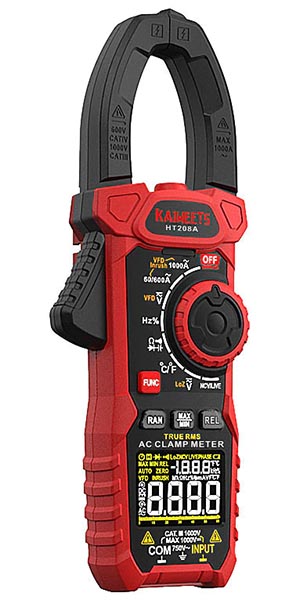
Functions
The Kaiweets HT208A Digital Clamp Meter has a lot of features built into one. Most notable, it’s designed for delivering accurate measurements for AC current, 1000V AC/DC voltage, frequency, duty cycle, resistance, capacitance, diode, continuity and temperature. Although it does not mesure DC current, it’s capable of reading Inrush Current. With this, it can assist you in locating a startup problem in less time. Whether the issue is apparent in the motor or in the starting circuit, it’s built for troubleshooting.

The HT208A has VFD, LOZ, MAX, MIN, REL, RAN, Date Hold functionality. In fact, there’s even a low battery display with automatic shutdown if you don’t use the clamp meter within a given time. Not only does this save battery life, it’ll assure that it will function properly the next time you go to use it. If there’s no operation within 15 minutes, the device will beep consecutively (3 times) and automatically power off. Best of all, the multi-functional ability is ideal for both home use or laboratory environments. With it, you’re able to use it in a wide range of scenarios. There’s even a built-in LED flashlight for added convenience.

Accuracy
Overall, the Kaiweets HT208A is reported to be very accurate. Although we highly recommend familiarizing yourself with it by reading the instructions, usage is quite easy. Simply select the mode of choice and apply the clamp around the wire. The small LCD screen will then display, down to the decimal, the reading for whichever unit you are measuring. In the box there’s a pair of thermocouples and test leads that are well-made and lengthy enough for most standard operations. In addition, Kaiweets even includes a carrying case for easy storage.
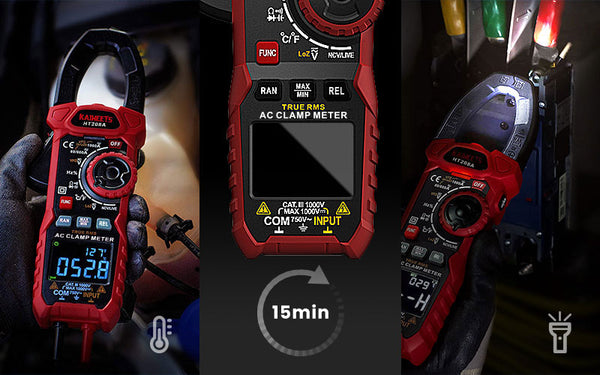
Safety & Suitability
The HT208A is built to specific standards that assure both safety and compatibility. Most notable, the standards it conforms to are as follows; IEC 61010-1, CAT IV 600V, CAT III 1000V. We love the fact that Kaiweets choose to use a double insulation layer with the use of high-grade materials. Not only does this help to prevent harm from electrical shock, it assures the unit will last for several years down the road. In fact, they even include a 3-year warranty in case anything malfunctions or doesn’t perform as expected.
Amprobe AMP-210 Clamp Meter
Amprobe products are designed to be complete. These are not accessories you use in conjunction with another meter, they’re one-stop-shop products for those who want to cover all of their electrical testing needs in one go. They’re designed to be affordable, focusing on real-world use. These meters should be considered informational tools. They’ll tell you all of the information you need to make decisions about safety and troubleshoot devices, but they are not designed for those who need extreme precision for calibration and configuration.
Functions
The Amprobe AMP-210 Clamp Meter is designed primarily for use on AC circuits. The dial on the front allows you to choose between capacitance, capacitive resistance, current, and voltage.
The current measurement is divided into two categories for use. Most users will use the standard current measurement, which is displayed by the symbol of the clamp meter with a large dot in the middle. This tells you the current in Amps, and can display information with up to four significant figures. For diagnostics of small equipment, the microcurrent measurement (small dot) displays information in tenths of an amp. This makes it a great universal meter for measuring virtually any AC device.
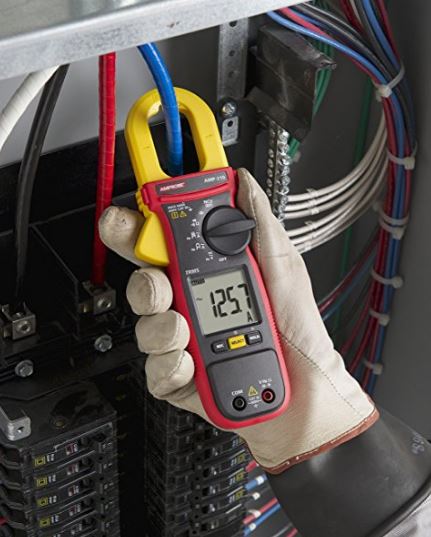
As with most meters, you can also measure voltage. A nice surprise was the fact that it supports DC voltage as well, which is useful for troubleshooting transformers or small electronics.
One of the unique features about this meter is the fact that it supports the measurement of capacitance. Many motors and compressors require an extremely high supply of current to start, but this drops off in a fraction of a second. Without a capacitor, you’d blow the breaker every time you started a device. To compensate for this, many appliances are fitted with capacitors that act as storage for electricity, helping to smooth out the initial current spike. The meter is capable of testing these capacitors by measuring its ability to store electricity. This reading can be compared against the specifications to determine if the capacitor is operating within range.
Accuracy
The most important feature to look for in any clamp meter is the ability to read true RMS current. The power being fed into your home is a pure 60 hz sine wave. This is a nice smooth supply of power that is completely undistorted. But most devices change this current in order to operate. Variable frequency drives (VFDs) are a type of motor that allows the speed to be adjusted by quickly pulsating the power on and off.

For illustration purposes, let’s say you have a motor that required 5 amps to run. To run it at half speed, the 5 amp supply would pulsate on a 50% duty cycle. A standard clamp meter would average this out and give you a reading of 2.5 amps. This would lead a technician to think that the motor was not being supplied with enough current, when in fact it is receiving the correct 5 amp signal.
RMS meters give you the actual reading of the current, even when the signal is distorted. This is a basic requirement of any high-end clamp meter.
One bonus feature of this meter is the low-level filter. Sometimes, you might have other electric devices in the same breaker, or additional components of a singular appliance that feed noise onto the line. These can cause serious measurement errors as the meter is trying to read two different sources as a singular reading. This meter can filter out noise, giving you the most prominent signal on a line.
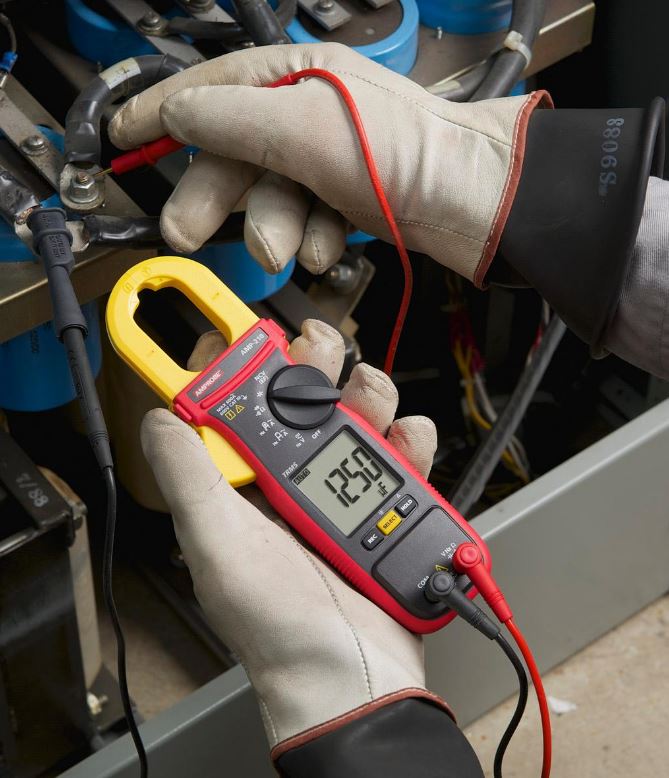
Safety & Suitability
The AMP-210 is rated for 600-volt service. While this is enough for use in industrial environments, the meter isn’t accurate enough for high level technical jobs. The entire unit is geared towards those who want to diagnose an repair appliances. It can help you verify specifications, and determine if components are functioning correctly. That being said, this meter is often purchased by starter electricians. They might not be required to use the tool for their job, but it’s helpful to have something that you can familiarize yourself with an electrical environment, so you’ll be ready when the time comes to take on additional responsibility.
Fluke 323
Fluke is one of the most respected brands when it comes to electrical test equipment. Their products range from affordable meters in the mid double digits, all the way up to high end calibration gear that can cost more than a small car. Professionals rely on Fluke gear because it is always extremely accurate, and extremely reliable. Just a quick look through eBay will turn up countless fluke meters that are upwards of 30 years old. While we wouldn’t put those products in the same category as what we’re looking at today, the fact that they’re still operational to their original specification really says a lot about the brand.
Functions
The Fluke 323 is capable of measuring AC current all the way up to a staggering 400 amps, roughly 10 times more current than you’ll ever encounter in a standard household. It can measure both AC and DC voltage up to 600 volts without ever going outside of it’s calibration specification, and resistance up to a whopping 4 kiloohms. These functions are all laid out with their own separate notch on the selection wheel.
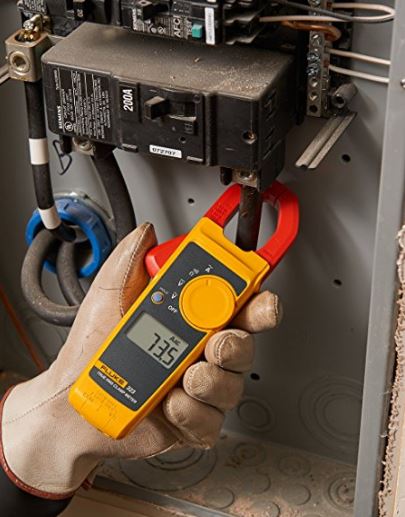
One bonus function is the ability to test for shorts. Turn the wheel to the resistance function and press the button on the face of the unit. Any time there is a signal path between the leads, you’ll hear a tone coming from the meter. This is great for testing cables or tracing signal paths. You can leave the meter on the ground and quickly run through 20 or even 30 cables to find out which one is connected to wherever you have the negative lead placed.
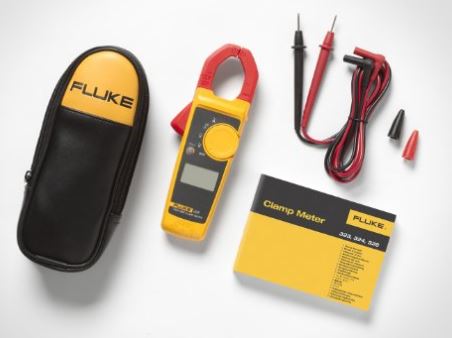
Accuracy
This meter is accurate within 2% of the measured variable. The fact that it’s 2% of the measurement is key. If you were to measure 100 amps, you’d know that it’s between 98 and 102 amps. Some meters are accurate to within 1% of the range. While 1% error looks like it would be more accurate than 2%, a meter that can handle 400 amps could be out by as much as 4 amps. With this meter, the smaller your measurements are the smaller your error is. A 1 amp reading will be within 0.98 amps and 1.02 amps. Even if you’re performing calibrations or configuration, this level of accuracy is enough for virtually all purposes.
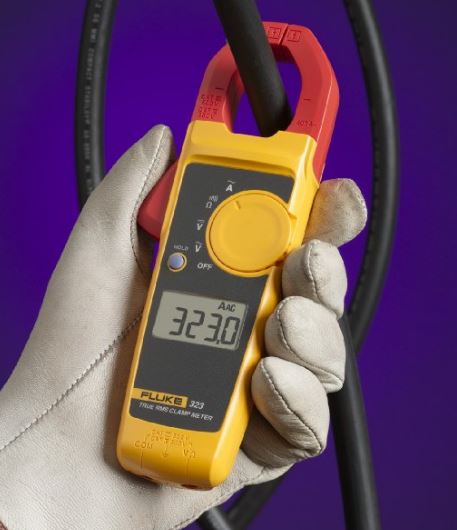
Safety & Suitability
This meter is CAT IV rated for 600 volts. This means that if you’re working in a commercial or industrial environment, you’ll be legally allowed to use this meter in dangerous environments. CAT testing is very rigorous, so you know that this is a trust worthy tool for any professional.
Uni-T UT210E
Despite being one of the most affordable meters on our list, the Uni-T UT210E has all of the basic functionality you’d expect from a clamp meter. The only thing this model has in common with the cheap, disposable meters you see flooding the market is the price, everything else is built to a very high standard, making it a great addition to any toolkit.
Functions
This clamp meter is designed primarily for measuring current. To make it easy, current measurement is broken up into three different ranges: 0 to 2A, 0 to 20A, or 0 to 100A. But in a pinch, it can also be used to measure resistance or AC voltage.
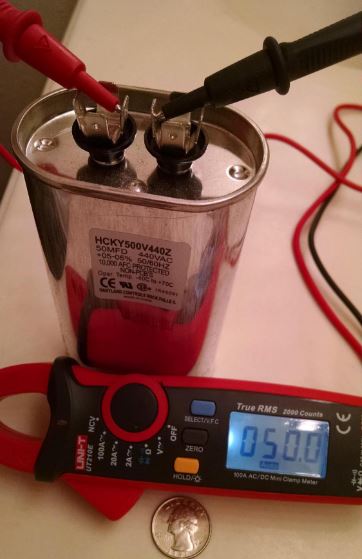
Accuracy
Current measurements are accurate to within 5%, and voltage within 3% of the measured variable. Like most inexpensive meters, this makes it suitable for troubleshooting but not configuration. You can tell if components are doing their job, but you won’t be able to pick up the minute details.
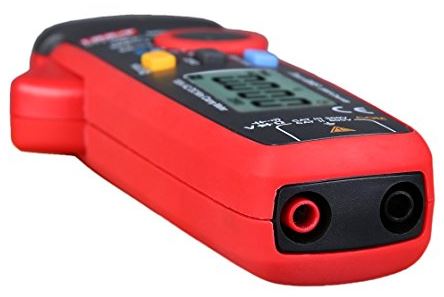
Safety & Suitability
This meter is fused, durable, and has a reasonably small range. This makes it suitable for any low risk activity. Troubleshooting any household electronics is no problem, although it shouldn’t be used in a professional or industrial capacity.
Which Clamp Meter is Right for Me?
The two most important factors in selecting a clamp meter is the other tools in your toolbox, and the job you need it to do. If you don’t have a suitable meter for working with AC equipment, do yourself a favor and pick up an Amprobe Clamp Meter. This meter has the full spectrum of features that you’d need for testing AC devices, and several features that make it particularly well suited for appliance repair and diagnostics. If you’re trying to save a few bucks, the Kaiweets HT208A will likely suffice as well.
In a professional environment, the best choice is the Fluke 323. This meter is designed to be used in conjunction with a proper multimeter. This tools is accepted in commercial and industrial environments, making it the perfect companion to your other fluke meters.
If you already have a multimeter but don’t have a way to measure AC current, add an inexpensive Uni-T UT210E to your arsenal. This is a very inexpensive meter, but it’s still accurate enough to perform diagnostics.
Other Considerations
No matter which meter you chose, make sure that you’re in possession of a non-contact voltage tester. AC current can be very dangerous, and it’s essential to be absolutely sure that a cable isn’t live before working on it.
If you’re planning to do more work with voltage and resistance, you might be better off with a digital multimeter. Clamp meters are generally used alongside multimeters, as an alternative way to measure current in situations where doing so traditionally would be dangerous.
It’s also important for us to highlight the difference between current and power. Current is the measure of electrical flow at a given voltage. A clamp meter will tell you how much power something is using from a diagnostic perspective, but if you’re interested in learning about your power use from an efficiency and finance perspective you’ll be better off to go with a power consumption meter.
Meet Ry, “TechGuru,” a 36-year-old technology enthusiast with a deep passion for tech innovations. With extensive experience, he specializes in gaming hardware and software, and has expertise in gadgets, custom PCs, and audio.
Besides writing about tech and reviewing new products, he enjoys traveling, hiking, and photography. Committed to keeping up with the latest industry trends, he aims to guide readers in making informed tech decisions.


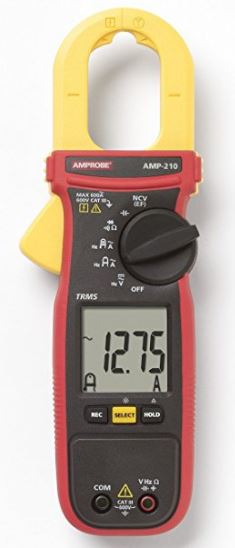
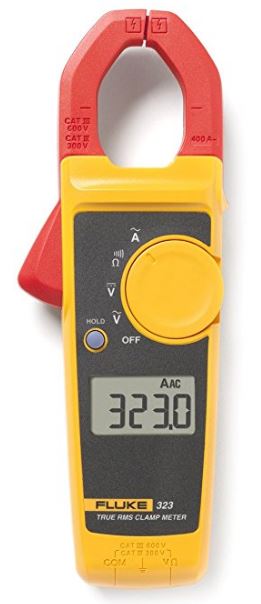
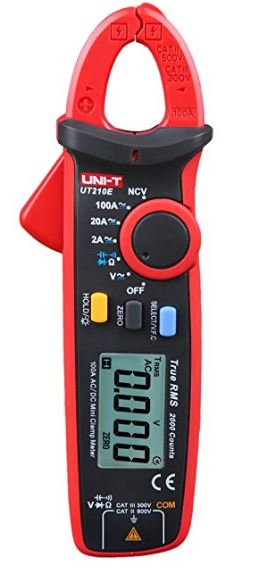
Thanks. You said: “you’ll be better off to go with a power consumption meter”. Why?
I mean what is the difference between amperometric clamp and power meter?
I want it to calculate how much power devices are using to buy appropriate uninterruptible power supply (UPS), to know how much power the whole house is using to contract appropriate power from electricity company (the more you contract, the more you pay, even if you do not use it), etc.
Hi TechGuru, I think that you approved my message above. If possible, I will appreciate your expert answer to my question above. Which is best for my purpose indicated above, an amperometric clamp and power meter? Thanks in advance.
Aren’t you neglecting the + X LSD (least significant digit) of the accuracy? I think Amprobes can be much more accurate for low amp readings. The amprobe has a resolution of 0.01 amps and the fluke has a resolution of 0.1 amps. Therefore when they both say 2% + 5LSD that means a lot for lower end measurements. For example a true 5 amp current will measure +/- (0.2% + 0.05A) on the amprobe and +/-(0.2% + 0.5A) on the Fluke. So the amprobe will be off by a max of 0.15A (4.85-5.15) and the Fluke will be off by a max of 0.6A (4.4-5.6A). For a 2 Amp current the Amprobe would read 1.91-2.09A and the Fluke would ready 1.46A – 2.54A.
I guess you need to know your application. If you’re in industrial power, likely measuring amps below 5A accurately will be mostly meaningless to you, but for some the amprobe would be more accurate.
Hi
I am working in indian railways and my job profile is working on dg set. 750vac 3 phase 4 wire system.
I also need to measure dc current.
Kindly suggest which clamp meters are best for me.
Thanking you.
I am an apprentice electrician on my 2nd year. I own two meters one the klein mm100 and amprobe 210. I just bought the amprobe. When I got it home I tested it out and compared it to the klein. On my outlet at home the klein gave me a reading of 120.1 while the amprobe gave me a reading of 120.3. I was very happy to see that both meters were very close to each other. They both had pretty much the same functions the klein mm100 does not have a clamp and amprobe does. Glad I bought the amprobe.